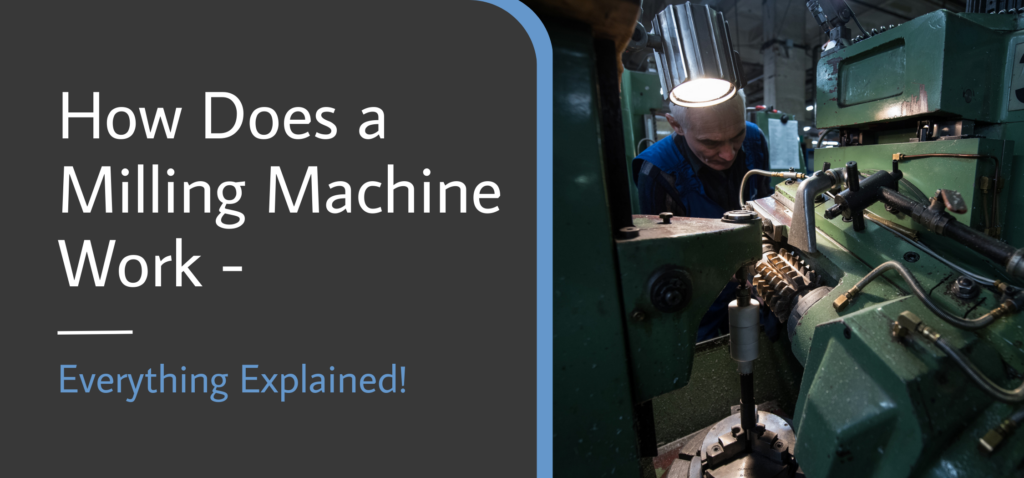Disclaimer: As an Amazon affiliate, I may earn a small percentage from qualifying purchases. This is at no extra cost to you. Learn more here.
Milling is one of the most common manufacturing processes in the machining industry. But many people find themselves asking, how does a milling machine work?
If your operation doesn’t include a milling machine, consider investing in one for its versatility and efficiency.
Whatever milling operation you need, a machine can produce the desired results with any material.
Find out everything you need to know about how milling machines work in this article.
Key Takeaways:
- The milling process removes material using different cutting operations to achieve the desired shape.
- There are different types of mills: vertical, horizontal, special, CNC, and universal milling machines.
- A milling machine can give great precision, increase production, and have various uses.
What Is a Milling Machine and How Does It Work?

Milling is a common form of machining in the manufacturing industry.
A milling machine works by using a rotary cutting tool to remove material from a workpiece to create different products and parts.
There are two MAIN types of milling machines:
- Vertical milling machines
- Horizontal milling machines
The cutting occurs on the circumference of the cutter due to the perpendicular motion of the tool axis.
A milling machine uses cutting tools with multiple cutting edges to operate on flat or irregular surfaces.
It has multiple cutting points to shave off chips from the workpiece.
When the milling cutter enters the material, the cutting edges of the machine tool repeatedly cut into the workpiece.
To remove unwanted material, the tool is operated at a high speed or advanced through the cutter slowly.
The speed at which a workpiece moves toward the milling cutter is called feed rate.
What Are the Different Applications of Milling Machines?

Milling machines can perform milling operations such as drilling, boring, and face milling of contoured surfaces, slotting, or flat surfaces.
Often used for metalworking, it can also machine wood, glass, plastics, and other rigid materials.
Compared to drilling, where the tool moves on its rotation axis, a milling cutter moves perpendicular to its own axis.
With a milling machine, the shear deformation removes material in small fragments that clump (to a greater or lesser extent) to form chips.
This feature is a SIGNIFICANT difference between cutting metal and slicing softer materials.
History of the Milling Machine

Milling machines were initially developed to reduce the hand filing of complex designs and shapes.
The earliest known use of milling machines was by clockmakers during the 17th century.
Eli Whitney later created a similar device and was credited for the invention of the first milling machine in 1818.
It was produced due to the demand for manufactured gun parts in the U.S.
Whitney soon developed a semi-automatic milling machine with a cutter that greatly improved production.
The most advanced milling machines today are CNC milling machines, which provide greater production output.
Types of Milling Machines

With milling machines, a machine operator can perform various metal fabrication jobs.
Most of these machines are made of temperature-resistant material to decrease friction and increase longevity.
Depending on the requirements, there is a milling machine that is more suited for the task than others.
See the FIVE different types of milling machines to better understand how they work.
1.) Vertical Milling Machines
A vertical mill has a vertically-oriented spindle axis.
The fixed spindle can be extended to perform different operations. It also has a moveable worktable that moves on two perpendicular slides.
Vertical mills can be used for other operations such as die sinking a large material and face milling a flat surface.
There are two kinds of vertical milling machines:
Turret Mill
With a turret milling machine, the worktable can move perpendicular or parallel to a fixed spindle, depending on the milling operation.
This production machine uses a quill that can be raised or lowered to mimic a drill press.
It works best for operating on small parts and other standard operations.
Bed Mill
In a bed mill, the spindle moves parallel to its own axis, while the worktable is capable of longitudinal movement.
This structure can handle demanding machining jobs and produce large volume outputs at a high speed.
It allows for various functions that are ideal for working with bigger materials.
2.) Horizontal Milling Machines
A horizontal milling machine has a horizontal spindle axis.
Most horizontal milling machines have rotary tables that can move vertically or horizontally. It can approach a workpiece at various angles to achieve more complex shapes.
A horizontal mill is capable of any milling operation at a faster rate than a vertical mill.
With their robust construction, horizontal mills are best suited for lengthy production of large workpieces.
3.) Special Milling Machines
Most milling machines of this type are intended for particular processes, such as making keys, grooves, and cavities.
Special milling machines are structured DIFFERENTLY than standard machines.
The milling head is affixed on a trolley operated by a rod-crank system. It allows for a straight horizontal motion.
4.) Universal Milling Machines
These milling machines combine the functions of a vertical and horizontal mill.
Universal milling machines are versatile equipment that can perform any milling operation, from slotting to shaping.
The worktable has a rotary feature that can be rotated at any angle, and the indexing head can operate on spiral surfaces.
5.) CNC Milling Machines
A CNC machine is a computer-controlled tool used to create complex parts.
CNC mills are built to automate the milling of different materials at fast speeds with high levels of detail.
Unlike manual milling machines, CNC machines simply read coded instructions to perform a milling operation.
These milling machines work with minimum human intervention to complete the process.
Advantages of Milling Machines

Milling machines are incredibly USEFUL in any manufacturing operation. They are efficient, versatile, and durable.
Let’s look at the BENEFITS that a milling machine can bring.
Increased Productivity
A milling machine automates the machining process to enable the production of small or large batches of parts.
It brings increased efficiency to any operation by making more parts quickly.
Among the milling machines available, a CNC mill can provide the best production benefits with large volume outputs and superior finish.
Accuracy
A vertical mill offers enhanced visibility during the machining process due to its vertical orientation.
It also uses thin tools designed to make shallow cuts for enhanced precision.
Customization
Milling machines can be equipped with multiple cutters that are able to do simultaneous cuts.
Horizontal mills are able to approach a workpiece from various angles, making it ideal for customizable cutting jobs.
It is also compatible with add-ons and features for more complex operations.
Wide Applications
Milling machines are multi-purpose equipment that can machine flat, conical, contoured, and helical surfaces.
These machining centers can readily produce intricate shapes and designs.
Frequently Asked Questions
Hopefully we’ve thoroughly answered, how does a milling machine work? Below are related questions about milling machines that many people ask.
What Are the Limitations of a Milling Machine?
Certain disadvantages restrict the functionality of a milling machine.
The drawbacks of this machine primarily stem from its size, axis movement, cutting capabilities, and cost.
Can You Mill With a Drill Press?
You can use a drill press ONLY if you intend to mill a soft material like plastic or wood.
The side pressure should be kept light, and the feed kept low to prevent damage to your drill press.
Can You Mill With a CNC Router?
Unlike a CNC mill, a CNC router is designed to operate on soft materials. You can mill wood with a CNC router, but not metals.
Conclusion
The quick answer to How does a milling machine work? is: A milling machine works by removing material from a stationary workpiece using various cutting tools.
It is an essential process in many manufacturing operations.
Getting the right machine is CRUCIAL if you want to maximize your operations.
I hope you learned what milling machines can do and how each type works best for certain applications.

